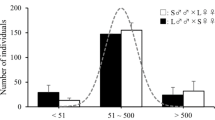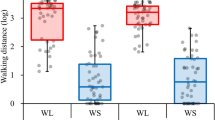Abstract
Reciprocal crossing of different strains is a suitable method to investigate the dominance and inheritance of a focal trait. Herein, we performed reciprocal crossing among strains of Tribolium castaneum exhibiting a genetically high (H strain) and low (L strain) moving activity and investigated the related heritable factors in the F1 and F2 generations. We also evaluated death-feigning behavior, which negatively responded to artificial selection for moving activity in T. castaneum. The results obtained for the F1 generation suggest that low moving activity and short duration of death feigning were dominant. In the F2 generation, movement and death feigning exhibited continuous segregation. The distribution of each trait value in the F2 generation differed from that in the parental generation, and no individuals transgressing the distribution of trait values in the parental generation emerged in the F2 generation. These results suggest that the genetic correlation between movement and death-feigning behavior is controlled in a polygenic manner. Moreover, the examination of the proportions of both behaviors (high vs. low moving activity and long vs. short death-feigning duration) in the F1 generation revealed that the two behaviors may be controlled by the maternal genotype, suggesting that the gene(s) that control movement and death feigning are located on the sex chromosome in T. castaneum.






Similar content being viewed by others
References
Bates D, Mächler M, Bolker B, Walker S (2015) Fitting linear mixed-effects models using lme4. J Stat Soft. https://doi.org/10.18637/jss.v067.i01
Brisson JA, Davis GK, Stern DL (2007) Common genome-wide patterns of transcript accumulation underlying the wing polyphenism and polymorphism in the pea aphid (Acyrthosiphon pisum). Evol Dev 9:338–346
Brisson JA, Ishikawa A, Miura T (2010) Wing development genes of the pea aphid and differential gene expression between winged and unwinged morphs. Insect Mol Biol 19(2):63–73
Campbell JF, Athanassiou CG, Hagstrum DW, Zhu KY (2022) Tribolium castaneum: a model insect for fundamental and applied research. Annu Rev Entomol 67:347–365
Clutton-Brock TH, Parker GA (1992) Potential reproductive rates and the operation of sexual selection. Q Rev Biol 67:437–456
Dingle H (2014) Migration: the biology of life on the move. Oxford University Press, USA
Dingle H, Drake VA (2007) What is migration? Bioscience 57:113–121
Falconer DS (1996) Introduction to quantitative genetics. Pearson Education, India
Fox J, Weisberg S (2019) An [R] companion to applied regression. SAGE, Thousand Oaks
Froy O, Gotter AL, Casselman AL, Reppert SM (2003) Illuminating the circadian clock in monarch butterfly migration. Science 300:1303–1305
Garland T Jr, Losos JB (1994) Ecological morphology of locomotor performance in squamate reptiles. Ecol Morphol Integr Org Biol 1994:240–302
Huey RB, Stevenson RD (1979) Integrating thermal physiology and ecology of ectotherms: a discussion of approaches. Am Zool 19:357–366
Irschick DJ, Garland T Jr (2001) Integrating function and ecology in studies of adaptation: investigations of locomotor capacity as a model system. Annu Rev Ecol Syst 32:367–396
Irschick DJ, Meyers JJ, Husak JF, Le Galliard J-F (2008) How does selection operate on whole-organism functional performance capacities? A review and synthesis. Evol Ecol Res 10:177–196
Lynch M, Walsh B (1998) Genetics and analysis of quantitative traits. Sinauer, Sunderland
Masaki S (1990) Effect of selection on wing dimorphism in the ground cricket Dianemobius fascipes (Walker). Boll San Veg Plagas (fuera De Serie) 20:381–393
Matsumura M (1996) Genetic analysis of a threshold trait: density-dependent wing dimorphism in Sogatella furcifera (Horváth)(Hemiptera: Delphacidae), the whitebacked planthopper. Heredity 76:229–237
Matsumura K, Miyatake T (2015) Differences in attack avoidance and mating success between strains artificially selected for dispersal distance in Tribolium castaneum. PLoS ONE 10:e0127042. https://doi.org/10.1371/journal.pone.0127042
Matsumura K, Miyatake T (2022) Polygene control and trait dominance in death-feigning syndrome in the red flour beetle Tribolium castaneum. Behav Genet 52:298–305. https://doi.org/10.1007/s10519-022-10108-9
Matsumura K, Yasui Y (2022) Genetic link between mobility and sexual attractiveness in male Tribolium castaneum beetles. Anim Behav 188:111–117. https://doi.org/10.1016/j.anbehav.2022.04.010
Matsumura K, Sasaki K, Miyatake T (2016) Correlated responses in death-feigning behavior, activity, and brain biogenic amine expression in red flour beetle Tribolium castaneum strains selected for walking distance. J Ethol 34:97–105
Matsumura K, Sasaki K, Miyatake T (2022) Responses to artificial selection for locomotor activity: a focus on death feigning in red flour beetle. J Evol Biol 35:855–867. https://doi.org/10.1111/jeb.14012
McCulloch GA, Oliphant A, Dearden PK, Veale AJ, Ellen CW, Waters JM (2019) Comparative transcriptomic analysis of a wing-dimorphic stonefly reveals candidate wing loss genes. EvoDevo 10:21
Miyatake T (1997) Correlated responses to selection for developmental period in Bactrocera cucurbitae (Diptera: Tephritidae): time of mating and daily activity rhythms. Behav Genet 27:489–498
Miyatake T, Katayama K, Takeda Y, Nakashima A, Sugita A, Mizumoto M (2004) Is death–feigning adaptive? Heritable variation in fitness difference of death–feigning behaviour. Proc R Soc Lond B 271:2293–2296
Miyatake T, Tabuchi K, Sasaki K, Okada K, Katayama K, Moriya S (2008) Pleiotropic antipredator strategies, fleeing and feigning death, correlated with dopamine levels in Tribolium castaneum. Anim Behav 75:113–121
Naylor AF (1961) Dispersal in the red flour beetle Tribolium castaneum (Tenebrionidae). Ecology 42:231–237
Oufiero CE, Garland T Jr (2007) Evaluating performance costs of sexually selected traits. Funct Ecol 21:676–689
Pai A, Feil S, Yan G (2007) Variation in polyandry and its fitness consequences among populations of the red flour beetle, Tribolium castaneum. Evol Ecol 21:687–702
Parker GA (1978) Evolution of competitive mate searching. Annu Rev Entomol 23:173–196
Reppert SM, de Roode JC (2018) Demystifying monarch butterfly migration. Curr Biol CB 28:R1009–R1022
Reppert SM, Gegear RJ, Merlin C (2010) Navigational mechanisms of migrating monarch butterflies. Trends Neurosci 33:399–406
Ridley AW, Hereward JP, Daglish GJ, Raghu S, Collins PJ, Walter GH (2011) The spatiotemporal dynamics of Tribolium castaneum (Herbst): adult flight and gene flow. Mol Ecol 20:1635–1646
Roff DA (1986) The evolution of wing dimorphism in insects. Evolution 40:1009–1020
Roff DA, Fairbairn DJ (1991) Wing dimorphisms and the evolution of migratory polymorphisms among the Insecta. Am Zool 31:243–251
Sokoloff A (1974) The biology of Tribolium, with special emphasis on genetic aspects. Oxford University Press, USA
Tada S, Honma K, Kakizaki M, Fujisaki K, Nakasuji F (1994) Genetic mode of flight muscle dimorphism in a scarabaeid, Heptophylla picea Motschulsky. Appl Entomol Zool 29:303–305
Team RC (2021) R: a language and environment for statistical computing. R Foundation for Statistical Computing, Vienna
Thornhill R, Alcock J (2013) The evolution of insect mating systems. Harvard University Press
Xue J, Bao YY, Li BL, Cheng YB, Peng ZY, Liu H, Xu HJ, Zhu ZR, Lou YG, Cheng JA, Zhang CX (2010) Transcriptome analysis of the brown planthopper Nilaparvata lugens. PLoS ONE 5:e14233
Zera AJ, Denno RF (1997) Physiology and ecology of dispersal polymorphism in insects. Anthony Zera Publications
Zhan S, Merlin C, Boore JL, Reppert SM (2011) The monarch butterfly genome yields insights into long-distance migration. Cell 147:1171–1185
Zhu H, Yuan Q, Briscoe AD, Froy O, Casselman A, Reppert SM (2005) The two CRYs of the butterfly. Curr Biol CB 15:R953–R954
Zhu H, Sauman I, Yuan Q, Casselman A, Emery-Le M, Emery P, Reppert SM (2008) Cryptochromes define a novel circadian clock mechanism in monarch butterflies that may underlie sun compass navigation. PLoS Biol 6:e4
Acknowledgements
This work was supported by Grant-in-Aid for Japan Society for the Promotion of Science (JSPS) Fellows to KM (no. 20J00383) and a grant from Grant-in-Aid for Scientific Research KAKENHI 21H02568 to TM.
Author information
Authors and Affiliations
Contributions
All authors conceived and designed the study. K.M. performed the experiment and analyses. All authors contributed to the interpretation of data and drafted the manuscript. All authors approved the final version and agree to be accountable for the content therein.
Corresponding author
Ethics declarations
Competing interests
The authors declare no competing interests.
Conflict of interest
The authors declare that they have no conflict of interest.
Additional information
Publisher's Note
Springer Nature remains neutral with regard to jurisdictional claims in published maps and institutional affiliations.
Rights and permissions
Springer Nature or its licensor (e.g. a society or other partner) holds exclusive rights to this article under a publishing agreement with the author(s) or other rightsholder(s); author self-archiving of the accepted manuscript version of this article is solely governed by the terms of such publishing agreement and applicable law.
About this article
Cite this article
Matsumura, K., Miyatake, T. Dominance and inheritance patterns of mobility and death feigning in beetle strains selected for moving activity. Genetica 151, 1–10 (2023). https://doi.org/10.1007/s10709-022-00174-6
Received:
Accepted:
Published:
Issue Date:
DOI: https://doi.org/10.1007/s10709-022-00174-6




